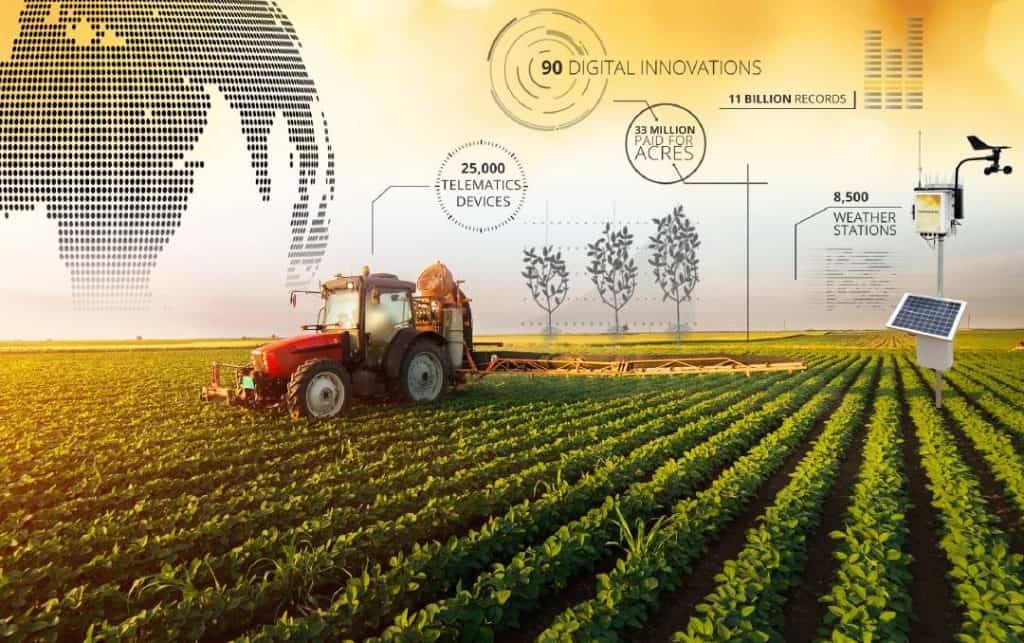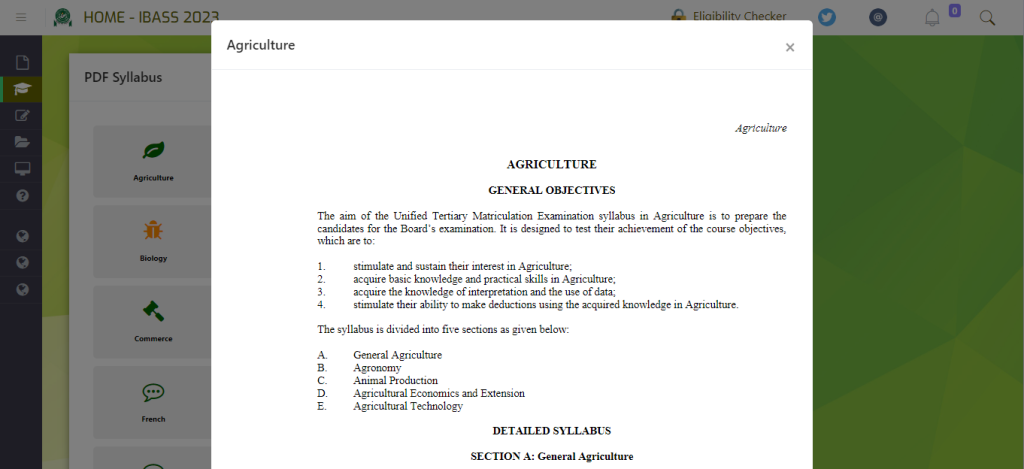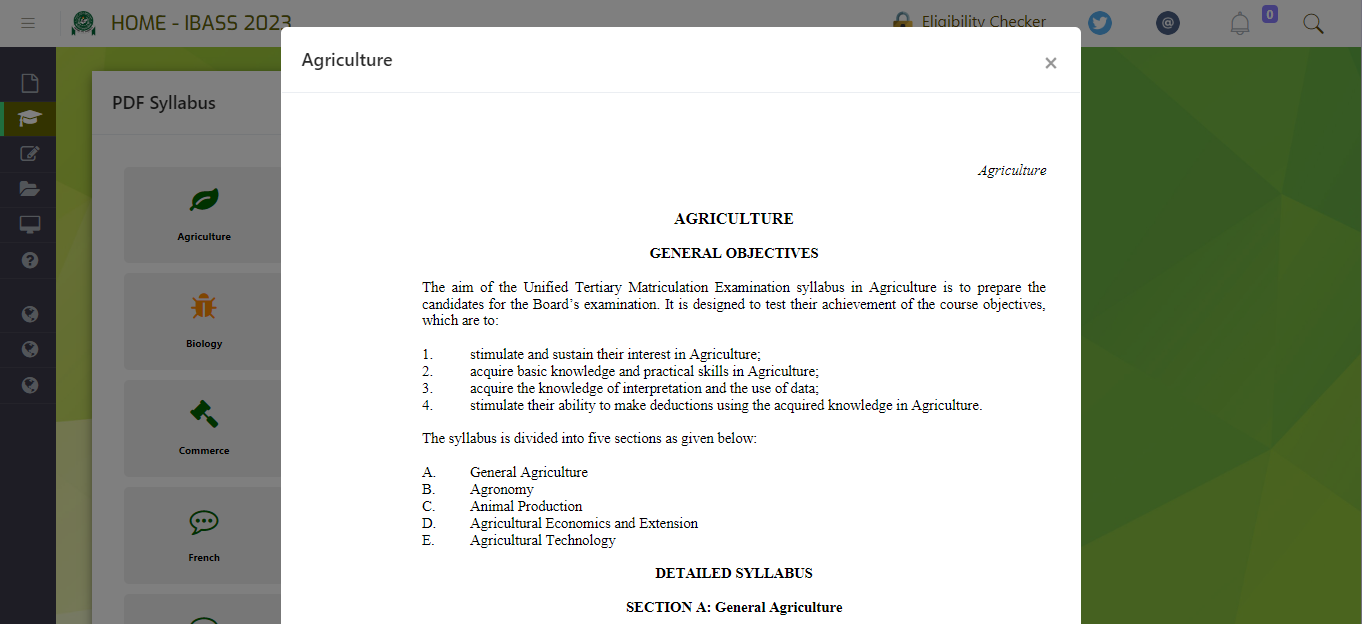JAMB Agricultural Science Syllabus: Is JAMB Syllabus for Agriculture out for this year JAMB? Agricultural Science JAMB Syllabus when will JAMB syllabus for agricultural science be out? What topics do JAMB set questions from Agriculture the most? what is the most repeated topic?
Welcome SAVANT! to another exciting episode of “JAMB Doctor Series” here we will provide you with official topics recognized by JAMB, which you are expected to conversant with before entering the hall to sit for your JAMB Agricultural science exam. STAY TUNED!

Have you ever wondered where you can find the topics for Agricultural Science that JAMB normally asks or the most repeated topics or question in JAMB Agric? then you are a step away from the answer
The short answer to this “JAMB Syllabus”, in fact, JAMB Syllabus is the only expo you will be getting as you prepare for 2024/2025 UTME Exams, this syllabus contains area of concentrations and topics your questions will be asked from.
Read Also: WAEC Marking Scheme For All subjects: Grading System
ARE YOU ON TELEGRAM? Subscribe To My Telegram Channel For Frequent Updates & Guide by clicking the "SUBSCRIBE NOW" button below.
Any smart students would cherish this piece (Syllabus) and make effective use of it, the fact that you are searching for this now, simply means you are in the right direction.
Agricultural Science JAMB Syllabus
JAMB Agricultural Science syllabus is designed to evaluate your ability to:
- stimulate and sustain their interest in Agriculture;
- acquire basic knowledge and practical skills in Agriculture;
- acquire the knowledge of interpretation and the use of data;
- stimulate their ability to make deductions using the acquired knowledge in Agriculture

This syllabus is divided into five sections:
- General Agriculture
- Agronomy
- Animal Production
- Agricultural Economics and Extension
- Agricultural Technology
Download your copy of the syllabus here👇
DrugSavant Editorial Team
Below is a detailed list of JAMB Chemistry syllabus For Agricultural Science
SECTION A: General Agriculture
1. Meaning and Scope of Agriculture
TOPICS:
- Definition of Agriculture
- Branches of Agriculture
- Types of Agriculture i.e subsistence and commercial
2. Importance of Agriculture
TOPICS:
- Provision of raw materials for agro-allied industries
- Provision of employment
- Development of rural areas, etc
3. Agricultural Ecology
TOPICS:
- Ecological zones of West Africa
- Agricultural products of each ecological zone
- Environmental factors and their effects on crop and livestock production
4. Genetics
TOPICS:
- First and second laws of Mendel
- Cell division
- Terminologies e.g locus, alleles, genotype, dominance
5. Farm Inputs
TOPIC:
- Planting materials, agrochemicals, etc.
6. History of Agricultural Development in West Africa
TOPICS:
- Agricultural systems e.g. shifting cultivation, bush fallowing e.t.c
- Problems of Agricultural development e.g land tenure systems, inadequate infrastructures, finance for agriculture, pollution, etc.
- Establishment of national research institutes e.g. NCRI, IAR, IAR&T, CRIN, NIFOR, FRIN, RRI, NRCRI, NIHORT, LCRI, e.t.c. and international research institutes e.g. IITA, ILRI, ICRISAT, WARDA e.t.c., leading to increased application of science to the development of agriculture.
- Agricultural Development Projects (ADPs) e.g. RTEP, FADAMA, etc.
- National agricultural programmes such as OFN, NAFPP, NALDA, Green Revolution, NCRPs, NARP, Project Coordinating Unit (PCU) e.t.c
7. Roles of Government and NGOs in Agricultural Development
TOPICS:
- Development of fiscal policies favorable to agricultural production e.g. import duties, ban on importation, e.t.c.
- Agricultural laws and reforms e.g Land Use Act.
- Government programmes aimed at agricultural development e.g. subsidies, credit facilities, e.t.c.
- Provision of infrastructures e.g. transport systems, communication systems, e.t.c.
- Contribution of NGOs to agricultural development
SECTION B: Agronomy
1. Rocks and Soil formation
TOPICS:
- Factors affecting rock weathering and soil formation
- Physical properties of soil
- Soil profile
- Soil texture and structure
- Chemical properties of soil
- Soil acidity and alkalinity
- Chemical component of soil e.g silicate
2. Soil Water and Soil Conservation
TOPICS:
- Soil water: its importance, sources, movement, management and conservation.
- Soil conservation: meaning and importance, causes, effects, prevention and control of leaching, erosion, continuous cropping, burning and oxidation of organic matter.
- Irrigation and drainage methods
3. Soil Fertility
TOPICS:
- Macro and micro-nutrients and their roles in plant nutrition: carbon, water and nitrogen cycles
- The living population of the soil (flora and fauna), and their roles in soil fertility
- Maintenance of soil fertility. Methods of maintaining soil fertility e.g. use of cover crops, application of organic manures, e.t.c.
- Nutrient deficiency symptoms e.g. chlorosis, sickle leaves, stunting, apical necrosis e.t.c.
4. Land Preparation and Soil Tillage
TOPICS:
- Principles and practices of land preparation and soil tillage
- Factors affecting choice of tillage methods: Zero tillage, minimum tillage, e.t.c.
5. Plant Forms and functions
TOPICS:
- Parts of monocot and dicot crop plants and their functions
- The anatomy and morphology of the storage organs of common crop plants.
6. Growth, Development, and Reproduction
TOPICS:
- Gametogenesis
- Pollination
- Fertilization
- Embryo formation and development
7. Plant Propagation Methods
TOPICS:
- Sexual: the use of seeds, seed viability, viability test, seed rate and seed germination
- Asexual (vegetative propagation) e.g. cutting, budding, grafting, layering, e.t.c.
- Nursery and nursery management
8. Cropping Systems, Planting Patterns and Plant Densities
TOPICS:
- Cropping systems: Monocropping, mixed-, multiple-, inter-, relay-, strip- and rotational cropping
- Planting patterns: Broadcasting, row spacing, and drilling
- Plant densities: single, double, and multiple stands
9. Crop Husbandry
TOPICS:
- Common and scientific names, gross morphology, anatomy of storage organs, methods of propagation, husbandry practices, harvesting, processing and storage, common diseases and pests, economic importance of the following groups of crops.
- Group 1: Cereals e.g maize, guinea corn, rice
- Group 2: Legumes e.g cowpea, groundnut, soyabean
- Group 3: Tubers e.g yam, cassava, sweet potatoes
- Group 4: Vegetables and Spices e.g tomatoes, eggplant, pepper, onion, okro, cabbage, amaranthus sp.
- Group 5: Fruits e.g citrus, pineapple, pawpaw
- Group 6: Beverages e.g cocoa, kola, coffee
- Group 7: Oils e.g oil palm, coconut, shea butter
- Group 8: Latex e.g para rubber, gum arabic
- Group 9: Fibres e.g jute, cotton, sisal hemp
- Group 10: Sugars e.g sugarcane, beet
10. Pasture and Forage Crops
TOPICS:
- Study of gross morphology, methods of propagation, and husbandry of common pasture grasses and legumes. Establishment, maintenance, conservation and uses of pastures and forage crops.
- Study of natural grasslands and their distribution in West Africa
- Range management
11. Floriculture
TOPICS:
- Identification, establishment, maintenance, and uses of ornamental trees, shrubs, and flowers
12. Weeds
TOPICS:
- Gross morphology, methods of reproduction, dispersal, and effect of weeds
- Weed control methods – weeding, mulching, cover cropping, tillage, herbicides, and trap cropping
13. Crop Diseases
TOPICS:
- Identification of disease-causing organisms both in store and in the field.
- A simple account of diseases caused by fungi, bacteria, nematodes and viruses; the nature of the damage, methods of transmission and common methods of control.
- Side effects of application of preventive and control methods e.g pollution, poisoning, and distribution of ecosystem.
14. Crop pests
TOPICS:
- General account of pests of agricultural plants both in the field and in the store, their types, importance, principles and methods of prevention and control
- Life cycles of: biting insects e.g. grasshopper; boring insects e.g. weevils; sucking insects e.g. aphids and cotton strainer.
- Common pesticides and their side effects
15. Forest management (Silviculture)
TOPICS:
- Importance: Source of wood, pulp, fibre and other forest products
- Conservation: regulation, exploitation, regeneration, afforestation, agro-forestry and taungya system
16. Crop improvement
TOPICS:
Methods of crop improvement e.g. introduction, selection, crossing, quarantine e.t.c.
SECTION C: Animal Production
1. Forms and classification of major farm animals in West Africa
TOPICS:
- Species, breeds and distribution
- External features of cattle, sheep, goat, pigs, rabbits and poultry
2. General terminology in animal production
TOPICS:
- Common terms used in animal husbandry, e.g. calving, kidding, castrate, capon, veal, mutton, e.t.c.
3. Anatomy and physiology of farm animals
TOPICS:
- Functions of tissues and organs of farm animals
- Animal body systems e.g. digestive (ruminants and non-ruminants), reproductive, respiratory, urinary (excretory), and nervous systems.
- Effect of environmental changes on physiological development of farm animals e.g climate change
4. Reproduction in farm animals
TOPICS:
- Gametogenesis, oestrus cycle, signs of heat and heat periods, secondary sexual characters, gestation periods, parturition and the role of hormones in reproduction.
- Development, nourishment and birth of the young. Mammary glands and lactation in farm animals.
- Egg formation, incubation and hatching in poultry.
5. Animal nutrition
TOPICS:
- Feed nutrients and functions
- Feeds and feeding: Simple ration formulation – balanced ration, common pasture/forage crops e.g. guinea grass, elephant grass, giant star grass. Andropogon sp, Calopogonium sp. Hay and silage preparation, different types of rations, namely maintenance ration and production ration.
- Nutrient deficiencies: Causes and symptoms of malnutrition and their correction in farm animals.
6. Livestock management
TOPICS:
- Housing, feeding, sanitation and veterinary care of ruminants, pigs, rabbits and poultry under intensive, semi-intensive and extensive systems of management from birth to slaughter.
7. Animal Health
- Animal diseases (pathology)
- Environmental factors, predisposing animals to diseases; causal organisms, symptoms, transmission, and effects.
- Preventive and curative methods for diseases caused by viruses, bacteria, fungi, and protozoa.
- Parasites (parasitology)
- Life cycles and economic importance of livestock parasites e.g. endoparasites, ectoparasites, and disease vectors.
- Prevention and control
- dipping
- spraying
- deworming
- sanitation
8. Fisheries and Wildlife
TOPICS:
- Fish culture systems; Common types of fishes e. g Tilapia, Catfish, etc.
- Extensive systems: inland and deep-sea fishing, lakes and rivers.
- Semi-intensive systems: dams
- Intensive systems: fish ponds – Factors to consider in ponds establishment and pond management e.g. pond fertilization, liming, and desilting.
- Fish harvesting and processing methods
- Use of drag nets, hook and line, etc.
- Curing, sun-drying, and smoking.
- Fishery regulations
- Wildlife management
- Habitat conservation, feeding, domestication, harvesting, processing and wildlife regulations.
9. Bee-keeping (Apiculture)
TOPICS:
- Meaning and importance of apiculture
- Types of bees e.g exotic and indigenous bees
- Methods of bee-keeping e.g traditional and modern bee-keeping
- Equipment and safety measures in bee-keeping
10. Animal Improvement
TOPICS:
- Methods of animal improvement e. g. introduction, breeding, quarantine, and selection: Breeding systems – inbreeding, line-breeding, cross-breeding, artificial insemination
SECTION D: Agriculture Economics and Extension
1. Factors of agricultural production
TOPICS:
- Land:
- Types of land ownership in West Africa
- Labour
- Capital
- Management
2. Basic Economic Principles
TOPICS:
- Demand and supply
- Production function:
- Input/input, Output/output, Input/output relationships; stages of production, concepts of diminishing returns, scale of preference, and choice.
3. Characteristic Features of Agricultural Production
TOPICS:
- Smallness of farm holdings: biological limits of farm production and susceptibility of farm production to climate, seasonality of farm productions, price elasticity in demand and supply of agricultural produce.
4. Labour Management
TOPICS:
- Labour relations: Supervision, etc.
- Types of labour: Permanent labour etc.
- National labour laws and regulations
5. Farm Management
TOPICS:
- Qualities, functions, and problems of a farm manager.
- Records and record-keeping: Types and importance of record-keeping – livestock records, profit and loss account book.
- Stock evaluation:
- gross and net profits in farm management.
- Appreciation, depreciation and salvage value
- Agricultural insurance:
- Meaning, importance and types of agricultural insurance
- Problems of agricultural insurance
6. Marketing of Agricultural Produce
TOPICS:
- Importance of Marketing.
- Marketing channels.
- Characteristic features of agricultural product affecting their marketing
7. Agricultural Extension
TOPICS:
- Meaning and importance.
- The role of Agricultural Development programmes, universities, research institutes, and farmers’ organizations (Cooperative societies).
- Extension methods including demonstration plots, use of visual aids, mass media, etc.
- Problems of agricultural extension in West Africa and possible solutions.
SECTION E: Agricultural Technology
1. Farm surveying and farmstead planning
TOPICS:
- Meaning and importance
- Common surveying equipment, their uses, and care
- Common survey methods
- Principles of farmstead outlay.
2. Simple farm tools
3. Farm machinery and implements
TOPICS:
- a. Types
- Machinery e.g tractor, milking machine, etc.
- Implements
- b. Uses and maintenance of farm machinery and implements
4. Mechanization and sources of farm power
TOPICS:
- Sources of farm power e. g. animal and machines
- Advantages and disadvantages of agricultural mechanization
- Problems and prospects of mechanized agriculture in West Africa
5. Processing and storage
TOPICS:
- Processing: traditional and modern methods of food processing e.g. gari, rice and groundnut processing, etc.
- Storage
6. Introduction to biotechnology
TOPICS:
- Basic terms, e.g. tissue and anther culture in vitro fertilization and genetic engineering
7. Application of ICT in agriculture
TOPICS:
- Features of computers
- Uses of computers in agriculture: disease and weather forecasting, ration formulation, database and simulation studies, etc.
- Use of communication gadgets to enhance agricultural production e.g mobile phone, internet, etc.
8. Introduction to agricultural research and statistics
TOPICS:
- Basic concepts in planning agricultural experiments e.g hypothesis, treatment, and control, etc
- Interpretation of results, e.g. measures of central tendency and experimental errors.
Frequently Asked Questions
Number of Questions JAMB Set In Agricultural Science
The total number of questions JAMB asked in Agriculture is 40, with each question carrying 2.5 marks.
This means if after answering Agric, you were able to answer 30 questions correctly in JAMB you have been able to secure 75 marks for yourself.
Is JAMB Agriculture Syllabus For 2024 Out?
Yes, JAMB syllabus for Agricultural sciene 2024 is out and can be downloaded here on DrugSavant or on JAMB IBASS
DrugSavant Editorial Team
In Conclusion
It is advisable you go through these topics listed here, as they would help you have a more directed preparation and reading for JAMB Agricultural Science.
This will be all for now, I understand you may have a question or two to ask, feel free to drop them using the comment box below!
Ensure to share this with friends on Facebook, Whatsapp, or any other social media network you can connect them with…
Related Searches... a. Jamb syllabus for agriculture pdf b. Jamb syllabus for agriculture 2024 c. jamb syllabus for all courses d. jamb syllabus for science courses



